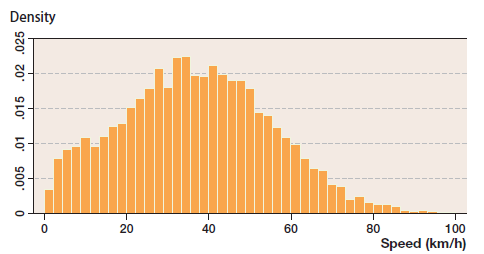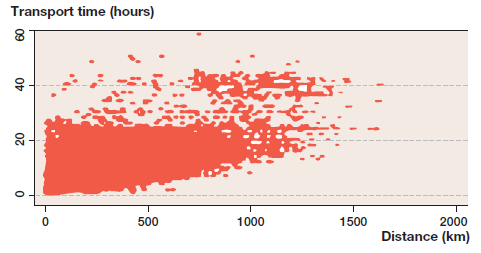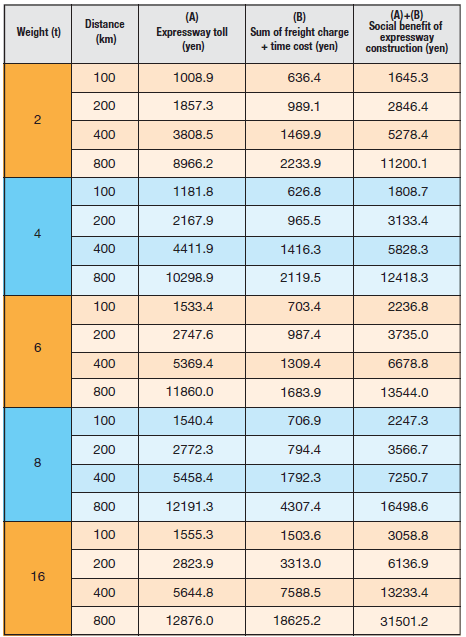| Interviewee | KONISHI Yoko (Senior Fellow, RIETI) |
|---|---|
| Issue date / NO. | Research Digest No.10 |
| Download / Links |
Despite the obstacles caused by the data constraints and diversity of industrial structure, analysis of the service sector is growing in importance. Focusing on one service industry in particular--freight transportation--a research team led by Senior Fellow Yoko Konishi set about analyzing the time cost as well as the monetary cost--cost of gasoline, expressway tolls, drivers' wages, and so forth--of transportation. In contrast with prior research, which has used supply side data, this study uses shipper data on the demand side to offer a new approach to measuring the time cost of freight transportation. With repair of the nation's aging expressways now a topic of concern, this approach allows the social benefits of road improvements and new construction to be measured, thereby making possible objective discussion based on quantitative assessments.
What concerns prompted this paper?
We have been measuring productivity in projects which aim to decompose economic fluctuations into demand and supply factors. In economic theory, productivity is measured from the supply side as it shows the technological capabilities of the firm or business. When productivity is measured in practice using data, however, it is influenced by demand and temporary or unpredictable shocks. Our research aims to eliminate these effects in order to measure genuine productivity.
Decomposing economic fluctuations into productivity and other factors is especially difficult in the service industries, where provision (production) and consumption occur simultaneously. In service industries where patterns of production resemble those in manufacturing, conventional approaches can be employed. For example, the restaurant business bears a strong resemblance to manufacturing (excluding the final stage of service, i.e., dealing with customers) in that it procures materials, prepares meals (to produce), cooks ahead (to keep in stock), and delivers (to ship) to the waiters. In such case, it might appear that approaches used in manufacturing could be applied just as they are. However, owing partly to the absence of any measures of productivity designed specifically for service industries, it is necessary to test how productivity should be measured in each individual service industry sector.
As sectors within service industries are extraordinarily diverse, we initially focused on personal services. Ultimately, we aim to develop a model for everyday retailing. We chose transportation this time as measuring productivity in logistics, which is part of firms' commodity purchasing, is crucial in measuring productivity in retailing. It should also be noted that transportation services play a role of linking consumers and producers.
Measuring productivity in service industries looks tricky.
In order to investigate productivity in service industries, it is necessary first to define the sources of value added in each sector, specify the model of production structure, and then test this model using a wealth of micro-level data. In our paper, we analyzed freight transportation using microdata, and found it considerably difficult to understand the structure of transportation services.
The four of us gathered and discussed transporting goods in a great deal of depth. One of the authors, Professor Se-il Mun, is a leading expert in transport economics, but I was a novice in the field and thus started off by learning the basics in areas such as transportation law and how discounting works with electronic toll collection (ETC) systems. Before long, I also became interested in truck sizes and shapes and, for example, how loading capacities affect driving performance. Now I cannot help but check out a truck's maximum load and how many drive axles it has whenever I see one drive by. Some day I would like to go on a tour of a truck plant.
Key to understanding production structures in service industries is to know the time inputs
What are the characteristics of service industries?
Let us answer this question by considering the freight transportation industry. The shorter the transport time is, the lower are the costs incurred by carriers, such as gasoline costs and drivers' wages. Thus, shippers in industries such as manufacturing and agriculture should enjoy greater benefits due to being able to deliver products to market more quickly and pay lower freight charges. Similarly, from the consumers' point of view, shorter transport times make it possible for perishable foods from distant locations to be delivered while still fresh, expanding the potential for consumption. Viewed in this light, "time" is evidently a factor of vital importance to transportation services.
Let us take another example: the beauty business. Professor Yoshihiko Nishiyama and I measured productivity in the beauty business and published in 2010 a discussion paper entitled " Productivity of Service Providers: Microeconometric Measurement in he Case of Hair Salons " (RIETI DP 10-E-051). Hairdressers may be assumed to offer a level of skill and quality of service commensurate with the salon where they work, with more highly skilled hairdressers being able to provide a certain level of haircut more quickly than less skilled ones. It may also be assumed that customer satisfaction declines if too much time is spent on giving the final touches to a haircut. In other words, time required declines as skill increases, and, as a result, customer satisfaction increases as the quality of service per unit of time increases. Additionally, a salon's turnover increases as its hairdressers' productivity increases. When we wrote this paper, Professor Mun observed that some aspects of this approach to "time" might also be applicable to the transportation industry, and that is how this research got underway.
So in service industries, are time inputs important?
Although this is not the case across the board in service industries, time inputs are certainly an important factor in those industries in which "time" is closely related to skill and customer satisfaction with the service provided. In the transportation industry, reductions in transport time and technological progress are inextricably linked. In our paper, we assumed transport cost to be expressed by monetary cost and time cost. Working on this basis, our objective was to measure the time value of transportation services.
Monetary cost consists of expenditures for gasoline cost and wage payment to drivers, which are easy to grasp. Time cost, however, is less familiar and is calculated by multiplying transit time by the time value obtained by converting the reduction in transport time to the corresponding monetary saving (in yen).
This works out as follows:
transport cost = monetary cost + time cost
time cost = value of time * transport time
With truck transportation, average speeds vary and delivery times are concentrated within 24 hours
Could you give us an overall picture of the situation in truck transportation?
Figure 1 shows the average speeds in truck transportation, from which we can observe that they vary. Such variation cannot be explained solely by factors such as road conditions, vehicles' performances, and drivers' skills. This suggests that carriers adjust arrival times; shippers' demands regarding delivery times vary.
Figure 1: Distribution of Average Transportation Speeds

Furthermore, let us consider the relationship between transport time and distance (Figure 2). Even over a distance of 500 km, for instance, transport times are quite different among shipments. It can be observed that transport times are concentrated around the 24-hour mark, regardless of distance. Whether or not transport time exceeds one day is an important concern when transporting goods.
Underlying the variations in average transport speeds and times among shipments, we assume that various adjustments and ideas are employed by carriers in an effort to provide transportation services efficiently while meeting shippers' requests.
Figure 2: Transport Times Against Distance

Could you let us know about the focus of analysis in your paper?
Our paper is distinguished by three features. First, it takes as its object of analysis freight transportation. Most of the existing literature on measuring value of time has focused on passenger transportation, and few contributions have been made on freight transportation due to the data constraints and its structural complexity. Furthermore, freight transport flows are highly heterogeneous: transported goods vary widely in size, weight, as well as in their contents. Pricing structures also differ depending on weight, distance, and other factors. As over 90% of freight in Japan is transported by truck, we selected truck transportation as the object of analysis for our paper.
Second, our paper is distinguished by its use of microdata from shippers rather than carrier data.
What kind of microdata did you use?
Two methods of measuring the value of time for freight transportation services commonly used in previous studies are the "factor cost method" and the "willingness-to-pay method." The former is based on the calculation of the monetary value of time saving from a carrier's cost reduction, and the latter is based on how much a carrier is willing to pay in tolls in order to save time by using expressways and similar means. However, it is natural to assume that the value of time for freight transportation to be reflected in the freight charges depends on whether or not a shipper (demand side) requests time-designated delivery or pays expressway tolls.
In our study, therefore, we used shipper (demand side) data instead of carrier (supply side) data. More specifically, we used microdata from the Net Freight Flow Census (NFFC) conducted by the Ministry of Land, Infrastructure, Transport and Tourism. This is a survey of manufacturing and wholesaling establishments; in other words, shippers. This data can be used to obtain information on origins and destinations at the municipal level, cargo weights, transport times, use (or not) of expressways, and specification (or not) of a time-designated delivery for individual shipments over a designated 3-day period in 2005. As this study focused on truck transportation, we excluded observations in regions that are inaccessible via road networks, namely, Hokkaido, Okinawa, and other islands. We assumed one truck is allocated for each shipment and used 42,823 samples for time-designated delivery and 5,130 for no time-designated delivery.
The third feature is our focus on the variation in average speeds and transport times as shown in Figures 1 and 2. Factors such as advances in technology--e.g., improvements in the performances and fuel efficiency of trucks themselves--and improvement of infrastructures--e.g., expansion, maintenance of expressways--all contribute to reducing transport time. However, the efforts made by carriers off the road must also be noticed. These include, for example, the accumulation of expertise in the smooth loading and unloading of cargoes and the cumulative impact of minor innovations in the form of tweaks to drivers' break times and allocation of human resources. These are considered to contribute to improvements in the productivity and efficiency of transportation. In considering time cost, therefore, we distinguished between improvements in truck performance and carriers' efforts contributing to reducing transport time and included this in our model.
Modeling the freight transportation market: Higher charges for faster delivery
Please describe the specific methods of your analysis.
In our paper, we analyzed the freight transportation market. On the demand side are shippers, and on the supply side are carriers. Shippers are assumed to prefer shorter transport times and therefore to choose carriers so as to minimize the sum of freight charges plus time cost.
Carriers, on the other hand, aim to maximize profits after deducting costs such as drivers' wage, truck rental, gasoline cost, and expressway tolls from freight revenues. We assumed that freight charges are determined when supply and demand are in a state of equilibrium. In our paper, expressway usage and transport time are supposed to be endogenous variables in determining the freight charge function. Carriers decide whether to use expressways according to circumstances, and this impacts transport time. Thus, we first estimated the expressway choice function, transport time function, and freight charge function, and then determined the value of time of transportation services.
What are the results of your analysis?
Using our method, it is possible to measure the value of time for various combinations of distances and cargo weights. By measuring the values of transport time for shippers of a 4-ton cargo over 200 km, which was the average combination in the sample, we obtained a value of 1,232 yen/hour for time- designated delivery and 1,966 yen/hour for no-time designated delivery. These values represent the extra amount of money that a shipper would be willing to pay to reduce transport time by one hour.
The method developed for measuring freight transportation can also be applied for analyzing other social capital
What are the policy implications of your paper?
We calculated the social benefit arising from time saving by constructing expressways. The social benefit is calculated by the following formula:
benefit = (freight charge without expressway + time cost) - (freight charge with expressway + time cost) + expressway toll
Table 1: Social Benefit from Time Saving by Expressway Construction (For the Case of Time-Designated Deliver)

Note that the use of expressways involves toll payment. From the society as a whole, toll payments and receipts should cancel one another out, and, accordingly, we should add the revenue from expressway tolls to the last term of the above formula.
The benefit enjoyed by shippers in the case of new expressway construction (decline in freight charge + time cost: [B]) is shown in column 3 of Table 1. Column 4 (A+B) represents the social benefit, which can be obtained from adding the benefit to expressway tolls. The social benefit is greater for longer distance when cargo weight is constant, and for heavier cargos with fixed distance. The social benefit in the average case where cargo weight is four tons and distance is 200 km is 3,133 yen, which is greater than that calculated by other methods described above (3,088 yen and 2,084 yen) using data on carriers. Considering also that expressway construction mitigates traffic congestion, the social benefit of building expressways is likely to be still greater.
With Japan's expressways aging, the need for repairs to be made has become a topic of concern. However, objectively discussing the importance of elements of social infrastructure such as expressways and the need for injections of funds is no easy matter. Applying the method that we have developed will make it possible to measure the social benefit arising from, for example, the construction of new expressways and so contribute to furthering objective discussion.
Could you tell us about what would be your future research agenda?
We try to perform more realistic analyses. At present, we use regional data to take into account the degree of competition of carriers at the prefectural level, population size, volume of physical distribution between two points, and other such factors. Yet, freight charges and value of time for transportation over, say, 300 km between Tokyo and Nagoya and the same 300 km travelled entirely on the island of Kyushu are likely to differ. In the future, therefore, we would like to create analytical and statistical models that allow the use of more detailed location and spatial data. For the sake of simplicity, in this study, we focused on transport service where a single chartered truck transports the goods ordered by a single shipper. In practice, though, trucks often transport consolidated shipments for multiple shippers, upon which we would like to try to model despite the greater complexity involved.
Looking further ahead, we aim to follow up our work on logistics by analyzing retailing. Here, too, there is a need for analyses based on information on the demand side, i.e., consumers, rather than relying on supply side data from retailers. In this sense, our analysis of the freight transportation industry represents an important step toward analysis of retailing.
Profile
KONISHI Yoko is a senior fellow at RIETI. Starting as a fellow at RIETI in 2008, she was also an advisory committee member of the Statistical Commission, Cabinet Offce in 2013; a visiting associate professor at the Institute of Economic Research, Kyoto University from 2013 to 2014; and a postdoctoral fellow for Research Abroad, Japan Society for the Promotion of Science (JSPS) from 2009 to 2011 (researched at Cowles Foundation for Research in Economics, Yale University). Her recent works include: " A Note on the Identification of Demand and Supply Shocks inProduction: Decomposition of TFP ," RIETI Discussion Paper, 13-E-099, 2013, (with Y. Nishiyama); " Decomposition of Supply and Demand Shocks in the ProductionFunction using the Current Survey of Production, " RIETI Discussion Paper, 13-E-003, 2013, (with Y. Nishiyama).


